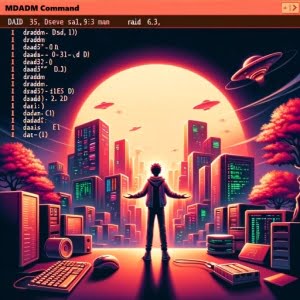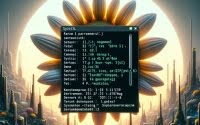mdadm Linux Command: RAID Array Management Guide

Are you finding it challenging to manage RAID arrays in Linux? You’re not alone. Many system administrators find this task daunting, but there’s a tool that can make this process a breeze. Like a Swiss Army knife, the mdadm command is a versatile tool for managing and monitoring software RAID devices. These devices can run on any Linux system, even those with minimal hardware resources.
This guide will walk you through using mdadm to manage RAID arrays in Linux. We’ll explore mdadm’s core functionality, delve into its advanced features, and even discuss common issues and their solutions.
So, let’s dive in and start mastering mdadm!
TL;DR: What is the mdadm command in Linux?
The
mdadmcommand is a utility in Linux used for managing and monitoring software RAID devices. It’s a powerful tool that can help you create, manage, and troubleshoot RAID arrays. It is used with the syntax,mdadm --[action] /dev/mdX --level=<RAID LEVEL> --raid-devices=<NUMBER OF DEVICES> <DEVICE1> <DEVICE2>...
Here’s a basic example of how to use it:
mdadm --create /dev/md0 --level=1 --raid-devices=2 /dev/sda1 /dev/sdb1
In this example, we’re using the mdadm --create command to create a RAID 1 array named /dev/md0 using two devices (/dev/sda1 and /dev/sdb1). RAID 1 is a mirrored set without parity, which means all data is written identically to two drives. This provides a high degree of data security, but at the expense of some storage efficiency.
This is just a basic way to use the mdadm command in Linux, but there’s much more to learn about managing RAID arrays with mdadm. Continue reading for more detailed information and advanced usage scenarios.
Table of Contents
Basic Use for Beginners: mdadm Command
The mdadm command in Linux is a powerful tool for managing RAID arrays. It allows you to create, manage, and monitor RAID arrays with ease. But like any other tool, it’s essential to understand its basic use before diving into more advanced features.
Creating a RAID Array
Let’s start by creating a RAID array. Here’s a simple example:
mdadm --create /dev/md0 --level=0 --raid-devices=2 /dev/sda1 /dev/sdb1
In this example, we’re using the mdadm --create command to create a RAID 0 (striping) array named /dev/md0 using two devices (/dev/sda1 and /dev/sdb1). RAID 0 helps increase performance by spreading data across multiple drives but doesn’t provide any redundancy.
Monitoring a RAID Array
Now, let’s check the status of our RAID array. You can do this with the --detail command:
mdadm --detail /dev/md0
This command provides detailed information about the RAID array /dev/md0, including its level, size, status, and more.
Pros and Cons of Using mdadm
Like any tool, mdadm has its advantages and disadvantages. On the plus side, it’s a versatile tool that supports multiple RAID levels, and it’s free and open-source. Additionally, since it’s software-based, it doesn’t require any special hardware.
On the downside, mdadm can be complex to use, especially for beginners. It also requires some system resources to run, which might impact performance on systems with limited resources.
Advanced Use and Analysis with mdadm
As you become more comfortable with the basic mdadm command, you’ll find that its true power lies in its advanced features. mdadm’s flexibility allows it to handle more complex RAID management tasks, such as managing RAID 5 or RAID 6 arrays, or using mdadm for monitoring and troubleshooting.
Before we dive into the advanced usage of mdadm, let’s familiarize ourselves with some of the command-line arguments or flags that can modify the behavior of the mdadm command. Here’s a table with some of the most commonly used mdadm arguments.
| Argument | Description | Example |
|---|---|---|
--create | Creates a new RAID array. | mdadm --create /dev/md0 --level=1 --raid-devices=2 /dev/sda1 /dev/sdb1 |
--detail | Provides detailed information about a RAID array. | mdadm --detail /dev/md0 |
--grow | Allows you to change the size, RAID level, or other characteristics of an existing RAID array. | mdadm --grow /dev/md0 --raid-devices=3 |
--fail | Marks a device as faulty. | mdadm --fail /dev/md0 /dev/sda1 |
--remove | Removes a device from an array. | mdadm --remove /dev/md0 /dev/sda1 |
--add | Adds a new device to an existing array. | mdadm --add /dev/md0 /dev/sdc1 |
--assemble | Assembles the components of a RAID array into an active array. | mdadm --assemble /dev/md0 |
--stop | Stops an active RAID array. | mdadm --stop /dev/md0 |
--scan | Scans for and assembles all arrays defined in the mdadm.conf file. | mdadm --scan |
--monitor | Monitors one or more RAID arrays for events. | mdadm --monitor /dev/md0 |
Now that we have a basic understanding of mdadm command line arguments, let’s dive deeper into the advanced use of mdadm.
Managing RAID 5 Arrays
RAID 5 is a level of RAID that provides data redundancy through a technique called ‘parity’. This means that if one drive fails, the data can be reconstructed from the remaining drives. Here’s how you can create a RAID 5 array using mdadm:
mdadm --create /dev/md0 --level=5 --raid-devices=3 /dev/sda1 /dev/sdb1 /dev/sdc1
In this example, we’re creating a RAID 5 array named /dev/md0 using three devices (/dev/sda1, /dev/sdb1, and /dev/sdc1).
Monitoring and Troubleshooting
The mdadm --monitor command can be used to monitor a RAID array for changes or failures. For example:
mdadm --monitor /dev/md0
This command will continuously monitor the RAID array /dev/md0 and print any events or changes to the console. This can be useful for troubleshooting or for keeping an eye on the health of your RAID arrays.
Managing RAID 6 Arrays
RAID 6 is similar to RAID 5, but it provides an extra level of redundancy by using two parity blocks instead of one. This means that a RAID 6 array can withstand the failure of two drives without losing data. Here’s how you can create a RAID 6 array using mdadm:
mdadm --create /dev/md0 --level=6 --raid-devices=4 /dev/sda1 /dev/sdb1 /dev/sdc1 /dev/sdd1
In this example, we’re creating a RAID 6 array named /dev/md0 using four devices (/dev/sda1, /dev/sdb1, /dev/sdc1, and /dev/sdd1).
Exploring Alternatives: Beyond mdadm
While mdadm is an incredibly powerful tool for managing RAID arrays in Linux, it’s not the only option available. There are other tools and methods, both software and hardware-based, that can also be used for RAID management. Let’s take a look at some of these alternatives, their benefits, and potential drawbacks.
Hardware RAID Controllers
Hardware RAID controllers are dedicated pieces of hardware that manage your RAID arrays. They can offer better performance than software solutions like mdadm, as they offload the RAID processing from the CPU. However, they are generally more expensive and can be more complex to set up and manage.
For example, here’s how you might create a RAID 1 array using a hardware RAID controller’s command-line interface:
ctrl slot=0 create type=ld drives=1I:1:1,1I:1:2 raid=1
In this example, we’re creating a RAID 1 array using two drives (1I:1:1 and 1I:1:2) on the controller in slot 0.
Other Software RAID Solutions
There are also other software solutions for managing RAID arrays in Linux. One such alternative is LVM (Logical Volume Manager), which provides a more flexible way of managing disk space. While it can be used in conjunction with mdadm to manage RAID arrays, it can also be used on its own to create logical volumes that can span multiple physical disks.
Here’s an example of how to create a logical volume using LVM:
pvcreate /dev/sda1 /dev/sdb1
vgcreate MyVolumeGroup /dev/sda1 /dev/sdb1
lvcreate -l 100%FREE -n MyLogicalVolume MyVolumeGroup
In this example, we’re first initializing two physical volumes with pvcreate, then creating a volume group with vgcreate, and finally creating a logical volume with lvcreate that spans the entire available space.
While these alternatives can offer additional options and flexibility, they come with their own complexities and learning curves. Therefore, it’s important to consider your specific needs and the resources available to you when choosing a RAID management solution.
Troubleshooting mdadm: Common Issues and Solutions
Like any tool, mdadm is not without its quirks and issues. However, with a bit of knowledge and some best practices, you can navigate these challenges with ease. Let’s look at some common issues encountered when using mdadm and how to solve them.
Degraded RAID Array
One common issue with RAID arrays is degradation. This happens when one or more devices in the array fail. Here’s how you can check for a degraded array with mdadm:
mdadm --detail /dev/md0
If the array is degraded, the output will indicate this, and you’ll see which devices have failed. You can then replace the failed device and rebuild the array. Here’s an example of how to do this:
mdadm --fail /dev/md0 /dev/sda1
mdadm --remove /dev/md0 /dev/sda1
mdadm --add /dev/md0 /dev/sdb1
In this example, we’re first marking the device /dev/sda1 as faulty, then removing it from the array /dev/md0, and finally adding a new device (/dev/sdb1) to the array. The array will then begin to rebuild.
Missing RAID Array
Another common issue is a missing or non-starting RAID array after a reboot. This can often be resolved by ensuring that the array is defined in the /etc/mdadm/mdadm.conf file and that mdadm is set to run at startup. Here’s an example of how to add an array to the mdadm.conf file:
echo "ARRAY /dev/md0 level=raid1 num-devices=2 metadata=1.2 name=my:raid UUID=3aaa0122:29827cfa:5331ad66:ca767371" | sudo tee -a /etc/mdadm/mdadm.conf
In this example, we’re adding the RAID array /dev/md0 to the mdadm.conf file. Replace the level, num-devices, name, and UUID with the values for your array.
Best Practices
When using mdadm, it’s important to follow some best practices to avoid common issues. Always ensure that your RAID arrays are defined in the mdadm.conf file and that mdadm is set to run at startup. Regularly monitor your arrays for degradation or other issues. And finally, always have a backup of your data. While RAID can provide redundancy, it is not a substitute for a good backup strategy.
Unpacking RAID: The Backbone of Data Storage
Before we delve further into the intricacies of the mdadm command, it’s important to understand the concept of RAID (Redundant Array of Independent Disks) itself. RAID is a method of storing the same data in different places on multiple hard disks to protect data in the case of a drive failure.
Why Use RAID?
RAID arrays offer several benefits, including improved performance, data redundancy, and increased storage capacity. By storing data across multiple disks, RAID allows for faster data access and increased fault tolerance. This means your system can continue operating even if one (or in some cases, more) disks fail.
Here’s an example of how data is stored in a RAID 1 array:
# Disk 1: A B C D
# Disk 2: A B C D
In this example, the same data (A, B, C, D) is mirrored on both Disk 1 and Disk 2. If Disk 1 fails, all the data is still available on Disk 2.
The Drawbacks of RAID
However, RAID isn’t without its drawbacks. The level of fault tolerance and performance improvement depends on the RAID level used, and some RAID levels require more disks, which can increase costs. Additionally, RAID isn’t a substitute for backing up your data. While it can protect against hardware failure, it can’t protect against data loss due to software errors, viruses, or accidental deletion.
How Does mdadm Fit In?
This is where mdadm comes into play. As a Linux utility, mdadm provides a way to manage RAID arrays. It allows you to create, manage, and monitor RAID arrays, making it a vital tool in a system administrator’s toolkit. By understanding the fundamentals of RAID, you can better use mdadm to manage your RAID arrays effectively and efficiently.
Expanding Horizons: Beyond mdadm
While mdadm is a powerful tool for managing RAID arrays in Linux, it’s just one part of the broader landscape of Linux system administration. Understanding related topics, such as file systems, disk partitioning, and other aspects of system administration, can further enhance your skills and knowledge.
File Systems and Their Role
A file system is a way of organizing and storing data on a storage device like a hard disk. Different file systems offer different features, such as performance, reliability, and security. For example, the ext4 file system, commonly used in Linux, supports large file sizes and has built-in recovery mechanisms.
Disk Partitioning: A Crucial Task
Disk partitioning is the process of dividing a disk’s storage space into separate sections, called partitions. Each partition can be used as if it were a separate disk. For example, in Linux, you might have a separate partition for your home directory (/home) and another for the root directory (/).
Here’s an example of how to list the partitions on a disk using the fdisk command:
sudo fdisk -l /dev/sda
This command lists the partitions on the disk /dev/sda. Each partition is listed with its size, type, and other information.
The Bigger Picture: Linux System Administration
Understanding RAID management with mdadm, file systems, and disk partitioning are all part of the larger picture of Linux system administration. System administrators are responsible for maintaining systems, ensuring their performance, security, and reliability. This involves a wide range of tasks, from user management to system updates, network configuration, and more.
Further Resources for Mastering Linux System Administration
To delve deeper into these topics, here are some resources that you might find helpful:
- The Linux Documentation Project: An ongoing project to document all aspects of Linux. It offers a wealth of guides and tutorials on various topics, including RAID, file systems, and more.
Linux Journal: An online magazine dedicated to Linux and open-source technologies. It features articles on a wide range of topics, including system administration, programming, and hardware.
Linux.com: A central source for Linux information, with a wide range of articles, tutorials, and news about Linux and open-source software.
Wrapping Up: Mastering mdadm for Efficient RAID Management
In this comprehensive guide, we’ve navigated through the complexities of the mdadm command, a powerful tool for managing RAID arrays in Linux.
We began with the basics, understanding what mdadm is and how to use it for creating and managing RAID arrays. We then delved into more advanced territory, exploring complex tasks such as managing RAID 5 and RAID 6 arrays, and using mdadm for monitoring and troubleshooting.
Along the way, we tackled common challenges you might encounter when using mdadm, such as degraded or missing RAID arrays, providing you with solutions and best practices for each issue.
We also looked at alternative approaches to RAID management, comparing mdadm with hardware RAID controllers and other software solutions like LVM. Here’s a quick comparison of these methods:
| Method | Flexibility | Cost | Complexity |
|---|---|---|---|
| mdadm | High | Free | Moderate |
| Hardware RAID controllers | Moderate | High | High |
| LVM | High | Free | High |
Whether you’re just starting out with mdadm or you’re looking to level up your RAID management skills, we hope this guide has given you a deeper understanding of mdadm and its capabilities.
With its balance of flexibility, cost-effectiveness, and power, mdadm is a go-to tool for managing RAID arrays in Linux. Happy managing!

